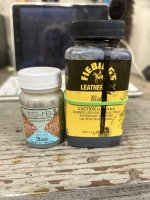Hobby block
- Thread starter breaog
- Start date
You are using an out of date browser. It may not display this or other websites correctly.
You should upgrade or use an alternative browser.
You should upgrade or use an alternative browser.
SmokingPipes.com Updates
Watch for Updates Twice a Week
Maybe post a picture. Not all briar grain is created equal. Some would stain it and them sand it to bring out contrast, but not all grain will react the same. I am NOT a woodworker, nor a pipemaker… so my knowledge is very limited on this.
I
just didn't know if wood stain reacts well with heat.Maybe post a picture. Not all briar grain is created equal. Some would stain it and them sand it to bring out contrast, but not all grain will react the same. I am NOT a woodworker, nor a pipemaker… so my knowledge is very limited on this.
The pipe started out as a kit pipe and the shank was out of line so I carved the pipe out of line.
In my limited knowledge, I do know that you shouldn’t use wood stains. Leather stains are what I see pipemakers using. I think the alcahol based ones are most used. There is a pipemakers forum, where this type of stuff is discussed with actual pipemakers. I just can’t remember the name of it.I
just didn't know if wood stain reacts well with heat.
Alcohol based leather dye, water based leather dye, or trans tint wood stain are what you want to use to stain a pipe. Do not use oil based or water based wood stain. Set the dye/stain with a flame and let fully dry for 24hours.
You can start with a dark stain, sand it off then apply a lighter stain for a contrast effect.
You can start with a dark stain, sand it off then apply a lighter stain for a contrast effect.
You also have the option of leaving it unfinished which will eventually allow it to develop color and over time, with luck, a kind of polished look, with no use of polish or wax. This does take some years, but the smoking in the meantime is usually good.
What is the reason for not using something like a Minwax stain? I saw a guy on YouTube who used Minwax Provincial, which is a nice color.Alcohol based leather dye, water based leather dye, or trans tint wood stain are what you want to use to stain a pipe. Do not use oil based or water based wood stain. Set the dye/stain with a flame and let fully dry for 24hours.
You can start with a dark stain, sand it off then apply a lighter stain for a contrast effect.
YouTube is an awesome place for truly awful information… Oil based stains contain toxic compounds, chiefly the oil. Not something you want to get hot and inhale.What is the reason for not using something like a Minwax stain? I saw a guy on YouTube who used Minwax Provincial, which is a nice color.
Thanks! Good info. I am really wanting to make one of my own just for the fun of it.YouTube is an awesome place for truly awful information… Oil based stains contain toxic compounds, chiefly the oil. Not something you want to get hot and inhale.
I am never used Fiebings on wood, but I have used it frequently to dye antler and bone when making knife handles. I'm sure it will work great on wood as well.I use these interchangeably. View attachment 230832
This thread reminds me, I think I still have a Plateau block somewhere that I started making a pipe about 30 years ago but never finished. I think I will have to find it and see if I can't finish it. Sounds like a fun project!
Alcohol dyes like Fiebing leather dyes are first choice, because they act quickly and you can easily sand darker or black stains off to get another lighter coat to get a nice contrasting stain.
Natural dyes like Coffee or tea also work out nicely. Takes a little more drying time. Wonder about what red cabbage might do.
I would finish the bowl before staining thoroughly, with 120, 240 and finer grit up to 400 and even 600 dry, and wet maybe up to 1000.
This thread is quite old, so what happened to your bowl, is the pipe ready???
Natural dyes like Coffee or tea also work out nicely. Takes a little more drying time. Wonder about what red cabbage might do.
I would finish the bowl before staining thoroughly, with 120, 240 and finer grit up to 400 and even 600 dry, and wet maybe up to 1000.
This thread is quite old, so what happened to your bowl, is the pipe ready???
I've carved a couple of blocks a fear years ago. I used plain olive oil and buffing. I've also used LIGHT shoe polish in a couple of estates which were discoloured with some success.
I finished the pipe. The only Finnish is beeswax. I didn't put too much into the Finnish because I got the walls too thin. One has developed a dark spot after smoking.









